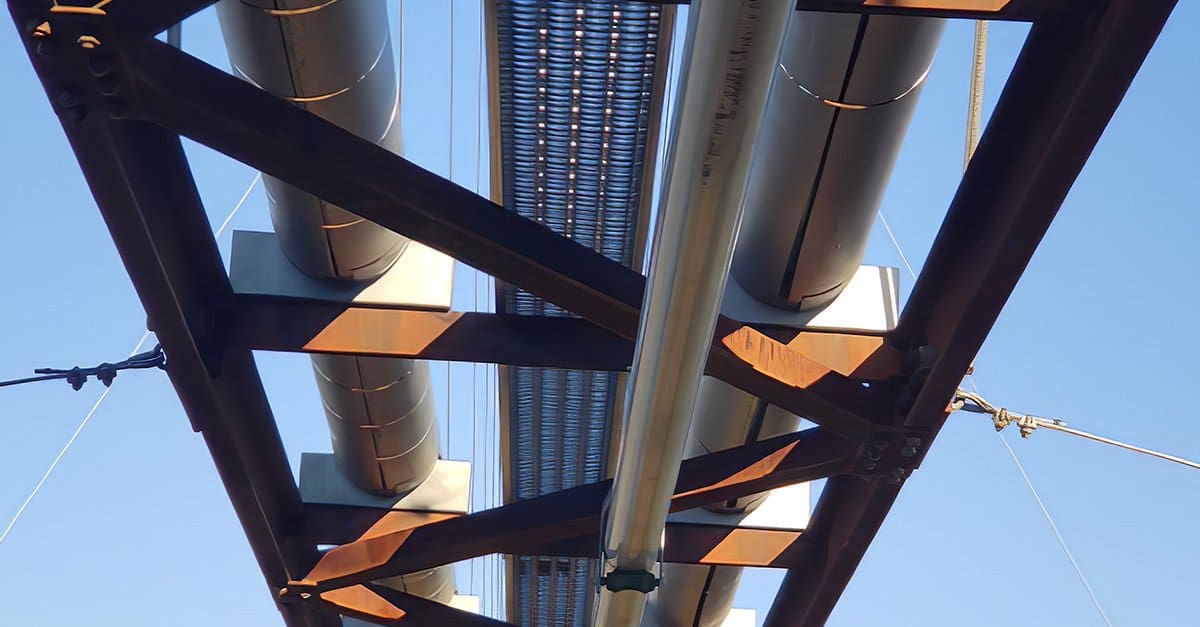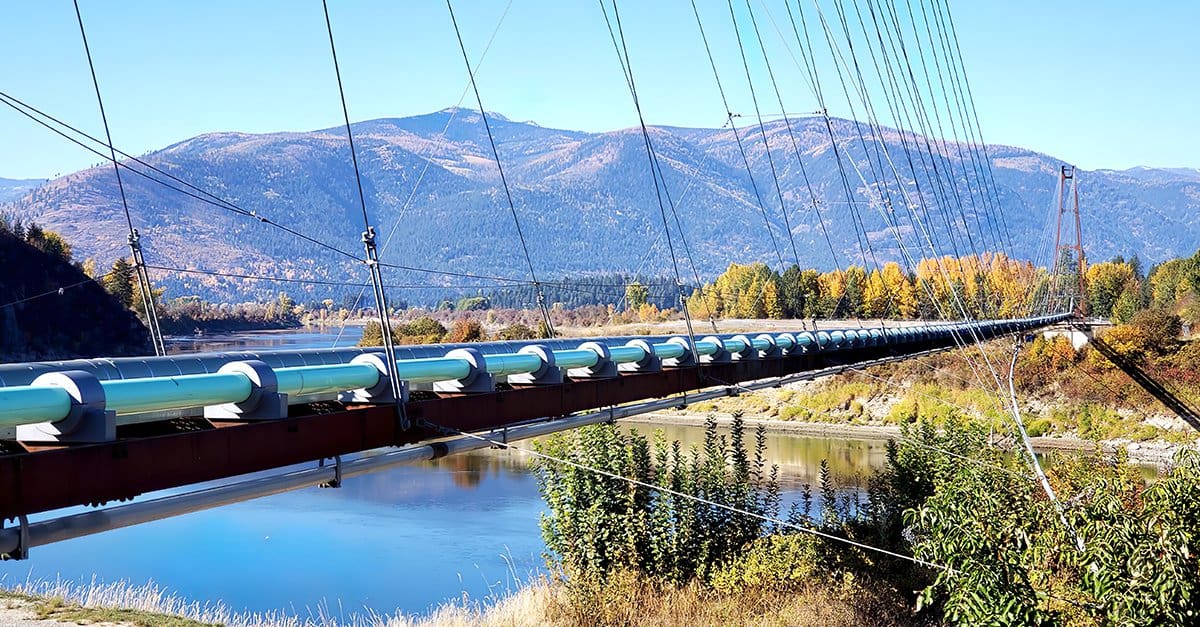When Selecting Water Main and Sewer Pipe Insulation for Bridge Projects, Durability and R-Value Reign Supreme
Harsh Conditions in a No-Mistake Zone Require a Product that Can Stand Up to Challenges For Decades
There is more than 800,000 miles of public sewer pipeline and 2.2 million miles of water pipeline making up our nation’s water and wastewater infrastructure. Within this network, these pipes are largely located underground, but frequently, there are sections that need to span the width of a river or canyon or gorge in order to connect point A to point B. In these cases, the pipelines are often attached in, under, or along the side of a bridge span.
Government municipalities and public utilities are typically responsible for the construction and maintenance of water and wastewater infrastructure. They design with the intention of placing these pipes underground wherever possible, but sometimes the only way across is over. Bridge pipelines are a necessity in certain circumstances, but maintaining and repairing them poses unique (and expensive) challenges that makes the success of their long-term functionality an imperative.
HSE Impact – Freezing Pipes Are Bursting Pipes
When it comes to the health, safety and environmental (HSE) impact of water and wastewater pipeline management, bursting pipes are problematic, to say the least. When those pipes are suspended over a river, the problems only compound. In order to avoid contaminating waterways and creating a public health hazard, water and sewer pipes, particularly ones that are not in constant use, require insulation to keep them from freezing. According to water and wastewater utility, WSSC’s Common Design Guidelines, all bridge-spanning pipes must be evaluated for potential freezing; and insulation, insulation shielding, and a plan for maintenance should be included in the design if required.
At the very least, the right insulation for a bridge pipeline application is one whose R-value can deliver sustained thermal stability over time. But because of bridges’ unique site conditions, there is actually much, much more to consider.

Thermal Stability is Just the First Step. Bridge Pipeline Insulation Also Needs to Stand Up to Salt, Storms, Vibration, Wildlife, and People
For the insulation to protect against freezing, it must be able to maintain R-value and integrity under the constant stresses that bridge pipelines are subjected to. In short, the insulation used in this environment needs to be durable.
A Few Issues Related to Bridge Pipeline Insulation Include
- Road Salt and Chemicals
- Independent Pipe and Bridge Expansion and Contraction
- Animals Nesting in the Insulation, or Tearing at it at Low Elevation Points
- Damage from Standard Bridge Repair and Maintenance
- Exposure to Extreme Heat and Cold
- Exposure to Weather Including Wind, Hail, Snow and Ice
- Vandalism
To stand up to these conditions, insulation needs to be tough and moisture impermeable. Unfortunately, common insulation materials aren’t known for either. In fact, foam, glass, mineral wool, and fiberglass pipeline insulation products are generally delicate and often require replacement after regularly scheduled pipeline inspections. Moreover, these insulation types require additional cladding to serve as a protective barrier between the insulation and the elements. This additional layer makes working with the insulation difficult and more hazardous in high places. It is also easily damaged, which can lead to moisture penetration and subsequent reduction in R-value.
Tough Situations Require Tough Insulations
With efficiency and safety being the primary objectives in engineering our products, Dragon Jacket Insulation Pipe Hangers, Pipe Saddles, Pipe Supports, and Flexible Connection Covers are ideal for bridge applications. Our products easily withstand the changing weather, vibration, moisture exposure, salt and oil exposure, and pipe or structure displacement typical in bridges. Dragon Jacket insulation is non-absorptive, CUI resistant and stands up to abuse from people, animals, and the elements.

Durability + Longevity = Money Saved and Improved Safety Over the Long-Term
For the insulation to protect against freezing, it must be able to maintain R-value and integrity under the constant stresses that bridge pipelines are subjected to. In short, the insulation used in this environment needs to be durable.
The height and precarious nature of bridges make maintaining and repairing pipeline expensive and risky. In terms of efficiency, the best choice for insulation in this situation is insulation that requires little, if any, maintenance, is easy to manipulate and is buoyant should it be dropped into a body of water. Dragon Jacket’s patented, fully encapsulated system is a single-piece design that requires no additional cladding, which makes for easier removal and reinstallation after pipe inspections.
The 2017 Infrastructure Report Card for Wastewater Infrastructure, cites the EPA’s assessment that US wastewater infrastructure needs approximately $271 billion in improvements over the next 25 years to support ailing systems. The report also states that:
“Cities and towns across the country report that complying with federal wastewater and stormwater regulations represents some of their costliest capital infrastructure projects…Approximately half of total annual expenditures in the wastewater sector go to operation and maintenance (O&M) and this share will likely rise further against capital investments. Since no federal funding may be used to pay for O&M, the full burden falls on rate payers.” (p. 3)
With budgets strained to their limits, and ratepayers on the hook to make up shortfalls, government municipalities and public utilities need to plan for infrastructure improvements with efficiency and economy in O&M as paramount concerns. Insulation, while it may seem a small part of a total project cost, has the potential to deliver years of avoided maintenance and replacement costs, improved safety, higher levels of energy efficiency and lower HSE impacts.
New Infrastructure Projects Need Insulation Designed to Go the Distance
Many new infrastructure projects have a predicted life span of 30+ years. Finding an insulation option to match that timetable is a challenge. The fact is that most insulation offerings can’t last a fraction of that time. That’s what makes Dragon Jacket a standout among the competition. Because it is so durable and reusable in nearly all instances, Dragon Jacket boasts a minimum lifespan of 20 years, making it an ideal choice for infrastructure projects that are designed to go the distance.




